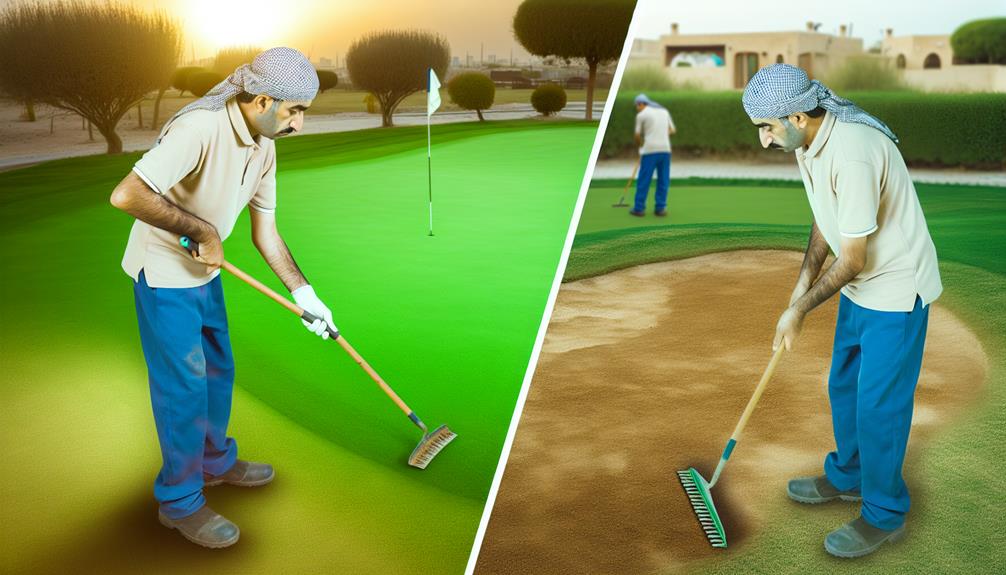Imagine, if you will, arriving at your local golf course only to be greeted by a sea of brown, ragged grass with more in common with the Sahara Desert than the lush, verdant putting greens you're used to. This isn't some dystopian nightmare, it's the harsh reality if proper maintenance is ignored on golf greens.
You see, the vitality of these seemingly simple patches of grass plays a pivotal role in your golfing experience. A poorly maintained green can drastically affect the playability of the course, leading to frustrated golfers and, ultimately, a loss of business for the course.
But how exactly does maintenance impact the greens, and why is it so crucial? Stick around, because we're about to unearth some key insights you won't want to miss.
Understanding Golf Green Construction
To truly appreciate the care your golf green requires, it's crucial to understand its construction process, which involves a precise blend of science, engineering, and artistry. This begins with the Green Design Principles, a set of guidelines that dictate the shape, contour, drainage, and overall aesthetics of the green.
Your green's design should promote smooth, consistent ball roll and challenge golfers without seeming daunting. It's a delicate balance, and achieving it requires a keen eye and a deep understanding of the game. The design also needs to incorporate a robust drainage system, so excess water doesn't pool on the surface and cause damage.
Once the design is finalized, Turfgrass Selection comes into play. It's not just about picking a grass that looks good, but about choosing a type that can withstand the rigors of constant play and thrive in the local climate. The wrong choice can lead to a frail, inconsistent green that's more work than it's worth.
Key Elements of Putting Green Maintenance
Understanding the unique construction of your golf green sets the stage for grasping the key elements of its maintenance, ensuring it remains in optimal condition for play.
Two critical components to this process include aeration techniques and turf nutrition.
Aeration involves perforating the soil to allow air, water, and nutrients to penetrate the grass roots. This helps the roots grow deeply and produce a stronger, more vigorous lawn. There are various aeration techniques, and the choice depends on the specific needs of your green. Core aeration, for instance, is ideal for compacted soils, while spike aeration is best for lightly compacted turfs.
Turf nutrition, on the other hand, is central to maintaining the health and vitality of your green. It's not just about applying fertilizer; you need to understand the nutritional requirements of your turf. Nitrogen, phosphorus, and potassium are essential nutrients that your turf needs to thrive. However, over-fertilization can lead to excessive leaf growth and reduced root growth. So, it's crucial to strike a balance.
Impact of Poor Maintenance Practices
Neglecting the proper maintenance of your golf green can have severe repercussions, leading to issues like weak turfgrass, increased susceptibility to diseases, and ultimately, a less enjoyable playing experience.
The deterioration consequences aren't just aesthetic. Poorly maintained greens become a breeding ground for pests and diseases, which can cause substantial damage to the turfgrass. Over time, this can lead to uneven playing surfaces, causing balls to veer off course and frustrating players.
As the turf weakens, it also becomes more vulnerable to environmental stresses, including extreme temperatures and heavy rainfall, potentially causing further damage. These factors can compound, leading to significant repair costs and extended periods where the green is unplayable.
Maintenance costs may initially seem high, but consider the alternative: the cost of restoring a poorly maintained green can be exorbitant. Not only do you have to rectify the damage, but there's also potential loss of revenue while the green is out of commission.
Enhancing Golfers' Experience Through Maintenance
Proper maintenance of golf greens not only preserves the course's integrity, but also significantly enhances a golfer's playing experience. Healthy, well-maintained turf provides a smooth, predictable playing surface, leading to increased player satisfaction.
Turf health is crucial. By maintaining the right moisture, nutrient levels, and regular aeration, you ensure the grass is healthy and resilient. Unhealthy turf, on the other hand, can lead to unpredictable ball roll and bounce, impairing a player's performance and overall experience.
But it's not just the physical characteristics of the course that benefit from proper maintenance. Aesthetically, a well-maintained golf green is more appealing. Seeing a vibrant, well-kept course can elevate a golfer's mood, making their game more enjoyable.
Regular maintenance also demonstrates respect for players. It shows you're committed to providing them with the best possible conditions, which in turn enhances their satisfaction and loyalty to your course.
Innovation in Golf Green Maintenance Techniques
While honoring traditional care practices, it's also important to embrace new innovations in golf green maintenance techniques that can further optimize turf health and player satisfaction. Advances in technology have introduced tools like Smart Irrigation systems and Robotic Mowers that are revolutionizing the way golf greens are maintained.
Smart Irrigation systems use weather data and soil sensors to determine the exact amount of water required by the green. This way, you're not overwatering or underwatering, but providing exact hydration to ensure a lush, healthy turf. It's efficient, environmentally friendly, and helpful in maintaining the perfect green conditions.
Meanwhile, Robotic Mowers offer consistency and precision, both vital for maintaining a golf green. These autonomous machines can be programmed to mow at specific times and patterns, reducing human error and freeing staff for other tasks. They're quiet, reducing noise pollution, and use electric power, cutting down on CO2 emissions.
These innovations not only improve the quality of the greens but also save time and resources, making maintenance more efficient. As you continue to uphold the highest standards in golf green care, consider incorporating these modern tools. They'll positively transform your maintenance routine and enhance golfers' experience on the green.

